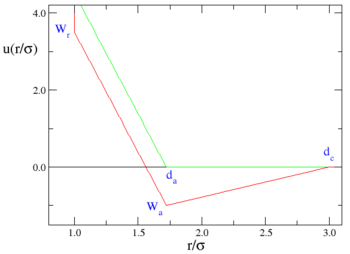Ramp model
The ramp model, proposed by Jagla [1] and sometimes known as the Jagla model, is described by:
where is the intermolecular pair potential, , and .
Graphically, one has:

where the red line represents an attractive implementation of the model, and the green line a repulsive implementation.
Critical points
For the particular case , the liquid-vapour critical point is located at [2]:
and the liquid-liquid critical point:
Repulsive Ramp Model
In the repulsive ramp case: ; neither liquid-vapor nor liquid-liquid stable equilibria occur (See Lomba et al. at the list of the references). However, for this model, it has been found a low density crystalline phase, This solid phase presents reentrant melting, i.e. It melts into the fluid phase at high pressure.
Recently, the same behavior has ben found in a three-dimensional lattice gas ramp model [3]
See also
References
- ↑ E. A. Jagla "Core-softened potentials and the anomalous properties of water", Journal of Chemical Physics' 111 pp. 8980-8986 (1999)
- ↑ E. Lomba, N. G. Almarza, C. Martin, C. McBride "Phase behaviour of attractive and repulsive ramp fluids: integral equation and computer simulation studies", Journal of Chemical Physics 126 244510 (2007)
- ↑ Johan Skule Hoye, Enrique Lomba, and Noe Garcia Almarza, One- and three-dimensional lattice models with two repulsive ranges: simple systems with complex phase behaviour Mol. Phys 2009
Related literature
- Limei Xu, Sergey V. Buldyrev, C. Austen Angell, and H. Eugene Stanley "Thermodynamics and dynamics of the two-scale spherically symmetric Jagla ramp model of anomalous liquids", Physical Review E 74 031108 (2006)
- Limei Xu, Sergey V. Buldyrev, Nicolas Giovambattista, C. Austen Angell, and H. Eugene Stanley "A monatomic system with a liquid-liquid critical point and two distinct glassy states", Journal of Chemical Physics 130 054505 (2009)












